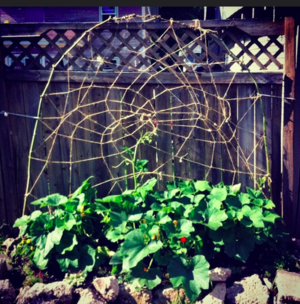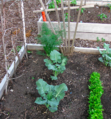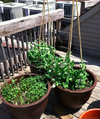
Structural supports are often helpful and even required devices when growing vegetables that have heavy fruits, climbing tendrils or fragile stems. Different types of structural supports can be used, depending on the type of plant being grown and many of them can be made from repurposed materials or simple materials available locally.
Whatever support you choose, ensure the following things:
- It is sufficiently high or wide enough to support the vegetable plant.
- It is firmly placed so that it cannot fall on the growing plants.
- It is free of toxic paint, varnish, coatings, etc., that might harm the plant, soil or consumer of the plant. Avoid using wood treated with chemicals intended to help it withstand outdoor conditions.
- Consider its aesthetic appeal in the garden - what is aesthetic is in the eye of the beholder, so it's up to you. Stakes, tripods, tepees, etc., can be decorated on top with ornaments, woven yarn, twig balls, and the like, to increase their aesthetic appeal.
- When choosing structural supports, bear in mind how many you need to fit within any space and how much room is left for the plants themselves.
Ideas for different types of supports are suggested below.
Some of the more common styles of support[edit | edit source]
- Single bamboo pole - This is good for vegetables grown in pots, such as tomatoes and capsicum (bell peppers). Use twine, yarn, covered wire, etc., as ties to keep the stem against the pole.
- Wooden garden stakes - this is the traditional structural aid. You can purchase these ready-made or make your own from scrap wood. Always use untreated wood.
- Tepee designs - This design is easy to make from bamboo stakes, thin branches, wire rods or similar items. Place the sticks in a tepee formation by placing in a circle around the intended growing space and tie together at the top with twine, rope, yarn, clothing, etc. The amount of poles used depends on the size and use of the tepee but generally the minimum should be three poles, and a good pea or bean tepee should have at least five poles. Trellis or mesh panels can be laid onto the tepee design to increase the support for growing vegetables.
- Wire mesh - Plants with tendrils, such as peas and beans, will happily climb up a backdrop of wire mesh. Plastic mesh can be substituted for wire mesh.
- Free-standing frames made from stretched wire netting - these can be good to support cucumbers, zucchini, etc.
- Trellises and latticework can be an excellent form of support for climbing vegetable plants such as peas and beans.
- Wooden archways, tunnels, and cones - Use a pliable wood such as willow wood. These can be both a support and focal point in the garden.
Brainstorming repurposed structural supports[edit | edit source]
Make use of items available for free or cheaply rather than buying expensive structural support. Here are some ideas:
- Old CD wire stands - put the unwanted CD stands to good use in the garden as vegetable supports. They are great for training tendrils in the direction desired and they also keep birds and animals off the plants if positioned strategically.
- Pallets can be stood upright against a fence, wall, etc. and will then support climbing vegetables or tall vegetable plants against them. Be sure to tie the pallet firmly or keep it held up with rocks, soil, tyres, etc., to prevent it from falling onto the growing plants during windy times.
- Old cookware - Think of grilling racks, wire cooling racks, oven racks, sieve mesh wire, etc. as excellent trellis or mesh-like supports just waiting for a new lease of life! When they're no longer wanted in the kitchen, put them to good use supporting plants in the garden.
- Broken furniture - Pieces of furniture such as dowels, poles, frames, chair bases, etc., can be repurposed as vegetable supports in the garden. Just a word of caution - be sure that the paintwork or finish on such items is safe for the plants.
- Broken garden tools - if they're beyond repair, they might have another use as structural supports in the garden.
- Tin cans - these can serve as good windbreaks/bird protection for seedlings when they are initially growing. Cut out both ends of the can before use and ensure that it is thoroughly washed and clean before using. Do not use if it has sharp edges, for the sake of your safety.
- Old tyres, bike wheels, etc. - these can be turned into great supports for vegetables, such as a tyre base for growing potatoes within or an old bike wheel stood upright for squash, peas and beans to grow tendrils onto.
- Plant pots and containers - these can easily be turned into supports and can do so while actively growing plants as well. Arrange differently sized pots to be wall-like supports in areas of the garden where they'll be most useful and consider planting additional plants within the pots, to keep the pots heavy and immovable.
Gallery of vegetable supports[edit | edit source]
Click on any of the images to enlarge for more detail.
-
Round supports for vegetables
-
Tomato stakes
-
Arched bamboo stakes for peas
-
Bamboo stakes used across garden
-
Bike wheel trellis
-
More bike wheel supports (with peas)
-
Fan-shaped trellis/stake base
-
Wire trellis support across garden bed
-
Bamboo trellis with duct tape and wire threads
-
Tepee support style in pots
-
Tepees made from branches
-
Row of tepee or tripod style with bamboo stakes











